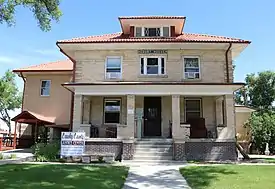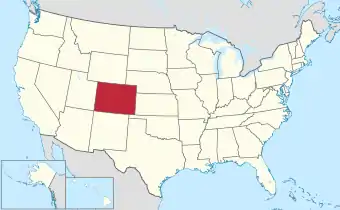Crowley County, Colorado
Crowley County is a county located in the U.S. state of Colorado. As of the 2020 census, the population was 5,922.[1] The county seat is Ordway.[2]
Crowley County | |
|---|---|
 The Crowley County Justice Center in Ordway. | |
 Location within the U.S. state of Colorado | |
 Colorado's location within the U.S. | |
| Coordinates: 38°20′N 103°47′W | |
| Country | |
| State | |
| Founded | May 29, 1911 |
| Named for | John H. Crowley |
| Seat | Ordway |
| Largest town | Ordway |
| Area | |
| • Total | 800 sq mi (2,000 km2) |
| • Land | 787 sq mi (2,040 km2) |
| • Water | 13 sq mi (30 km2) 1.6% |
| Population (2020) | |
| • Total | 5,922 |
| • Density | 7.5/sq mi (2.9/km2) |
| Time zone | UTC−7 (Mountain) |
| • Summer (DST) | UTC−6 (MDT) |
| Congressional district | 4th |
| Website | crowleycounty |
History
Crowley County was created by the Colorado legislature on May 29, 1911, out of the northern portions of Otero County. Previously both were parts of Bent County. The county was named for John H. Crowley, senator from Otero County to the state legislature at the time of the split. Its original inhabitants decades earlier were Native Americans, more Cheyenne than other tribes at the time the western expansion of the U.S. arrived.
The first significant development and settlement occurred in 1887 when the Missouri Pacific Railroad came through from the east, on its way to Pueblo and Colorado's rich gold fields of "Pikes Peak Or Bust".
The county seat is in Ordway, a town established in 1890 that quickly became the economic hub of the area. Other towns still existing along the Missouri Pacific Railroad's route are Sugar City, Crowley, and Olney Springs.
A few years later, developers brought a canal east from the Arkansas River, with ambitious plans to irrigate a million acres (4000 km2) in Kansas; instead, the canal petered out in Crowley County but did irrigate 57,000 acres (230 km2) along its length. This turned early Crowley County into a lush agricultural mecca at first.
By the 1970s almost all the water rights were sold from what is now called the Twin Lakes Canal to the fast-growing cities of Colorado's Front Range corridor. The area's economic activity has shifted toward ranching. Much of the land has returned to its original sparse prairie grassland conditions.
The Crowley School, which is now the Crowley County Heritage Center, is the county's only historic site listed on the U.S. National Register of Historic Places.
Crowley County also today hosts a state prison. The 2000 census showed 5,518 county residents, of which 1,955 were prisoners, giving Crowley County the highest percentage of incarcerated prisoners of any county in the U.S. The county maintained this position in the 2010 census, with 2,682 prisoners out of 5,823 residents.
Geography
According to the U.S. Census Bureau, the county has a total area of 800 square miles (2,100 km2), of which 787 square miles (2,040 km2) is land and 13 square miles (34 km2) (1.6%) is water.[3] Lake Meredith, which lies south of Ordway and Sugar City, is the largest of several lakes in the county.[4]
Adjacent counties
- Lincoln County - north
- El Paso County - northwest
- Otero County - south
- Kiowa County - east
- Pueblo County - west
Major highways
Bicycle trail
Demographics
| Census | Pop. | Note | %± |
|---|---|---|---|
| 1920 | 6,383 | — | |
| 1930 | 5,934 | −7.0% | |
| 1940 | 5,398 | −9.0% | |
| 1950 | 5,222 | −3.3% | |
| 1960 | 3,978 | −23.8% | |
| 1970 | 3,086 | −22.4% | |
| 1980 | 2,988 | −3.2% | |
| 1990 | 3,946 | 32.1% | |
| 2000 | 5,518 | 39.8% | |
| 2010 | 5,823 | 5.5% | |
| 2020 | 5,922 | 1.7% | |
| U.S. Decennial Census[5] 1790-1960[6] 1900-1990[7] 1990-2000[8] 2010-2020[1] | |||
As of the census[9] of 2000, there were 5,518 people, 1,358 households, and 957 families living in the county. The population density was 7 people per square mile (2.7 people/km2). There were 1,542 housing units at an average density of 2 units per square mile (0.77 units/km2). The racial makeup of the county was 82.95% White, 7.05% Black or African American, 2.59% Native American, 0.82% Asian, 0.02% Pacific Islander, 4.77% from other races, and 1.81% from two or more races. 22.54% of the population were Hispanic or Latino of any race.
There were 1,358 households, out of which 34.50% had children under the age of 18 living with them, 55.10% were married couples living together, 11.00% had a female householder with no husband present, and 29.50% were non-families. 25.70% of all households were made up of individuals, and 13.00% had someone living alone who was 65 years of age or older. The average household size was 2.59 and the average family size was 3.12.
In the county, the population was spread out, with 18.80% under the age of 18, 9.90% from 18 to 24, 39.60% from 25 to 44, 20.80% from 45 to 64, and 10.80% who were 65 years of age or older. The median age was 37 years. For every 100 females there were 205.40 males (this is the highest of any U.S. county/parish in 2000). For every 100 females age 18 and over, there were 240.90 males.
The median income for a household in the county was $26,803, and the median income for a family was $32,162. Males had a median income of $20,813 versus $21,920 for females. The per capita income for the county was $12,836. About 15.20% of families and 18.50% of the population were below the poverty line, including 23.60% of those under age 18 and 13.50% of those age 65 or over. More recent data, published in 2011, estimated that 48.1 percent of the county's residents lived in poverty, and of 3,197 counties ranked by the U.S. Census Bureau in 2011 for "estimated percent of people of all ages in poverty", Crowley was second.[10]
Census data for Crowley County includes 1,955 prisoners. The prison population is 19.23% Black, and 24.35% Hispanic. Without the prisoners, Crowley County would be 86.72% White, 0.36% Black, and 21.55% Hispanic. As a percentage of its population, Crowley County has more of its Census population in prison than any other county in the country.[11][12]
Politics
Crowley is a predominantly Republican county. No Democratic presidential nominee has won Crowley County since Lyndon Johnson's 1964 landslide. Before that time, the county largely followed the patterns of Colorado politics in general, from strongly Democratic during the William Jennings Bryan and Woodrow Wilson eras to Republican leaning from the time of Wendell Willkie onwards.
| Year | Republican | Democratic | Third party | |||
|---|---|---|---|---|---|---|
| No. | % | No. | % | No. | % | |
| 2020 | 1,271 | 72.63% | 437 | 24.97% | 42 | 2.40% |
| 2016 | 1,079 | 70.66% | 339 | 22.20% | 109 | 7.14% |
| 2012 | 924 | 61.52% | 535 | 35.62% | 43 | 2.86% |
| 2008 | 976 | 62.64% | 552 | 35.43% | 30 | 1.93% |
| 2004 | 1,006 | 67.38% | 478 | 32.02% | 9 | 0.60% |
| 2000 | 855 | 59.17% | 511 | 35.36% | 79 | 5.47% |
| 1996 | 680 | 49.60% | 559 | 40.77% | 132 | 9.63% |
| 1992 | 602 | 41.29% | 570 | 39.09% | 286 | 19.62% |
| 1988 | 862 | 57.47% | 630 | 42.00% | 8 | 0.53% |
| 1984 | 993 | 65.03% | 517 | 33.86% | 17 | 1.11% |
| 1980 | 926 | 62.86% | 472 | 32.04% | 75 | 5.09% |
| 1976 | 834 | 54.90% | 667 | 43.91% | 18 | 1.18% |
| 1972 | 1,094 | 70.67% | 414 | 26.74% | 40 | 2.58% |
| 1968 | 775 | 50.36% | 565 | 36.71% | 199 | 12.93% |
| 1964 | 690 | 41.49% | 967 | 58.15% | 6 | 0.36% |
| 1960 | 1,099 | 60.89% | 705 | 39.06% | 1 | 0.06% |
| 1956 | 1,220 | 62.05% | 745 | 37.89% | 1 | 0.05% |
| 1952 | 1,546 | 67.78% | 726 | 31.83% | 9 | 0.39% |
| 1948 | 1,027 | 50.34% | 1,004 | 49.22% | 9 | 0.44% |
| 1944 | 1,214 | 62.93% | 710 | 36.81% | 5 | 0.26% |
| 1940 | 1,419 | 62.21% | 850 | 37.26% | 12 | 0.53% |
| 1936 | 920 | 43.11% | 1,163 | 54.50% | 51 | 2.39% |
| 1932 | 811 | 38.31% | 1,266 | 59.80% | 40 | 1.89% |
| 1928 | 1,243 | 65.42% | 635 | 33.42% | 22 | 1.16% |
| 1924 | 1,087 | 50.23% | 667 | 30.82% | 410 | 18.95% |
| 1920 | 1,348 | 60.64% | 792 | 35.63% | 83 | 3.73% |
| 1916 | 847 | 40.47% | 1,160 | 55.42% | 86 | 4.11% |
| 1912 | 467 | 28.35% | 719 | 43.66% | 461 | 27.99% |
Communities
Towns
See also
References
- "State & County QuickFacts". United States Census Bureau. Retrieved September 4, 2021.
- "Find a County". National Association of Counties. Archived from the original on May 31, 2011. Retrieved June 7, 2011.
- "US Gazetteer files: 2010, 2000, and 1990". United States Census Bureau. February 12, 2011. Retrieved April 23, 2011.
- "Lake Meredith". Geographic Names Information System. United States Geological Survey, United States Department of the Interior.
- "U.S. Decennial Census". United States Census Bureau. Retrieved June 7, 2014.
- "Historical Census Browser". University of Virginia Library. Retrieved June 7, 2014.
- "Population of Counties by Decennial Census: 1900 to 1990". United States Census Bureau. Retrieved June 7, 2014.
- "Census 2000 PHC-T-4. Ranking Tables for Counties: 1990 and 2000" (PDF). United States Census Bureau. Archived (PDF) from the original on March 27, 2010. Retrieved June 7, 2014.
- "U.S. Census website". United States Census Bureau. Retrieved May 14, 2011.
- "Table 1: 2011 Poverty and Median Income Estimates - Counties". Small Area Income and Poverty Estimates. U.S. Census Bureau. 2011. Archived from the original on October 10, 2013.
- Wagner, Peter; ‘Twenty one counties have twenty one percent of their population in prisons and jails’; Prison Policy Initiative, April 19, 2004
- Prison Policy Initiative; ‘Racial Geography of Mass Incarceration – Appendix A. Counties: Ratios of overrepresentation’
- Leip, David. "Dave Leip's Atlas of U.S. Presidential Elections". uselectionatlas.org. Retrieved May 26, 2017.